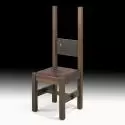Two Great Collections, Two Great Auctions

You could call it the ultimate in Arts and Crafts recycling.
Two great collections: one focused on the early work of Gustav Stickley’s Craftsman Workshops, the other focused on the early work of Elbert Hubbard’s Roycroft Furniture Shop.
Two great collections: one assembled in 1902 and kept intact for more than a century in a remote summer estate in the mountains of Colorado; the other assembled over the course of the past few decades by Christopher Forbes, son of billionaire Malcolm Forbes, and kept in his Colorado summer home less than three hundred miles away.
Both destined to be disassembled in 2012 and dispersed to other homes.
Industrialist John L. Jerome’s (1854-1903) collection of Gustav Stickley 1901-1902 furniture was entrusted to the staff at the John Toomey-Don Treadway auction gallery in Oak Park, Illinois, where it was sold this past May 20. Nearly every piece from his home, La Hacienda, featured its original finish, and collectors responded enthusiastically. The highlight of the sale was a 1901 leather-topped library table with inverted tapering legs. This piece was so distinctively “early Gus” that the lack of a red decal was inconsequential. The library table sold for a record $325,000.
Christopher Forbes turned the dispersal of his Roycroft collection over to his longtime friend and advisor David Rago and his staff at the Rago Arts and Auction Center in Lambertville, N.J. One hundred and thirty-two lots representing Forbes’ collection will be sold this coming Saturday, October 27.
Leading off the sale is perhaps the quintessential Holy Grail of Roycroft furniture: a simple, oak straight chair designed, built and carved by Dard Hunter soon after his arrival at the Roycroft campus in 1904. Beside a coat of arms carved into the single backrest are the words “Sit down & rest thy weary bones.” The chair has a presale estimate of $20,000-$30,000, but should race past the modest estimate, perhaps even before the first bid is taken from the audience. Besides wondering what the final price will be, the only question remaining is whether this chair goes back into a private collection or heads for public display at a major museum.
It isn’t often that we get the opportunity to study color photographs and descriptions of a complete collection of Roycroft furniture, especially one assembled by a collector to whom money was never a consideration. This collection, we can safely assume, represents the Best of the Best of Roycroft Furniture: carefully-selected bookcases, settles, chest of drawers, beds, sideboard, servers, tables, arm chairs, magazine stands, and no fewer than four massive Morris chairs.
It is a collection that deserves study, either in the printed catalog or online, for it reveals a great deal about the furniture Forbes himself once described as “ugly.” And it is difficult not to make the comparison to the furniture made a little more than a hundred miles away in Gustav Stickley’s Craftsman Workshops. Furniture was never a high priority for Elbert Hubbard, who never claimed to be a furniture designer and who never hired a professional furniture designer as qualified as those who worked for Gustav Stickley: Henry Wilkinson, Lamont Warner, Peter Hansen and Harvey Ellis.
Roycroft furniture is uniquely Roycroft.
Whereas Stickley furniture has spawned hundreds of imitators, hardly anyone went to the trouble to imitate Roycroft furniture. The same rings true today. It often seems to have been made for the sheer joy of making it, for the materials and labor required pushed the price even beyond that of Gustav Stickley’s furniture and out of reach of all but the wealthiest of the Roycroft clients. Hubbard never built a furniture factory for his small band of woodworkers. Mass production was never a goal. They worked in what looked like a large barn, and while they utilized power machinery, they seldom employed more than a dozen workers at one time and often nearly closed down when sales lagged.
So, why is Roycroft furniture still so eagerly sought, why does it still deserve mention in the same breath as Gustav Stickley, Leopold Stickley and Charles Limbert?
For the same reason that collectors still long for the work of Charles Rohlfs, the Rose Valley Shops, and the Byrdcliffe craftsmen.
They are among the small number of furniture makers who rejected mass production, even in the face of financial failure.
And for that reason it also is a true rarity.
It should be a great auction and one, I predict, will further cement the reputation of the Roycroft Furniture Shop.
Check back next week and we’ll see how it does…..

Until next Monday,
Have a great week!
Bruce
To view the Forbes collection and Rago auction schedule for this weekend, go to http://www.Ragoarts.com. It’s worth your time!
